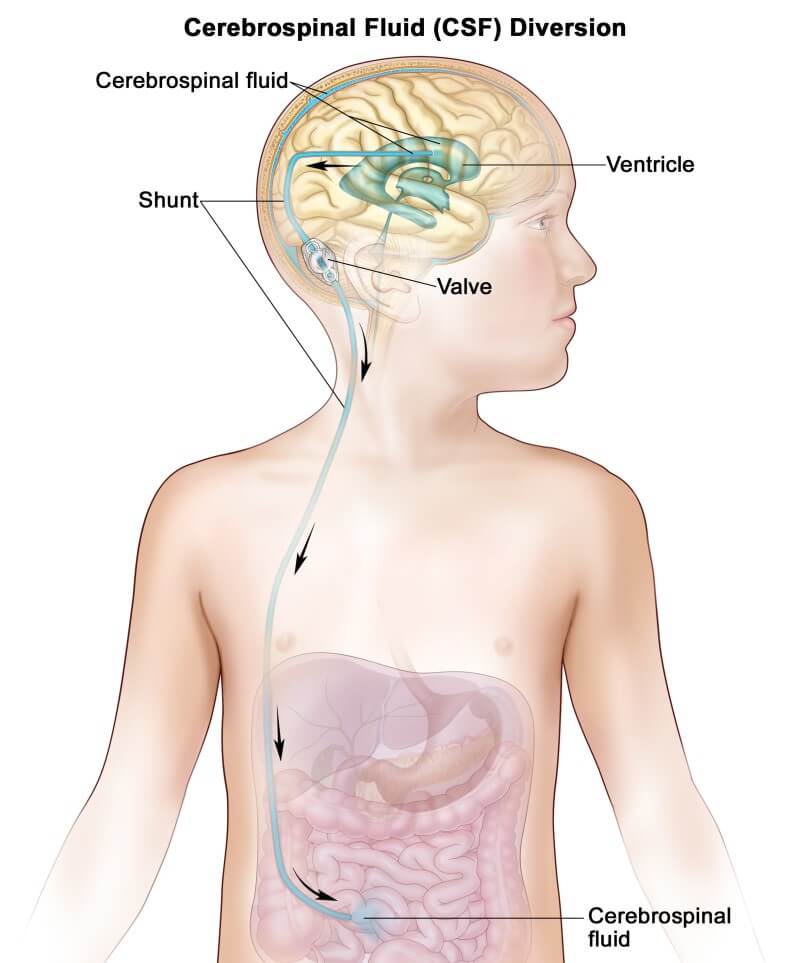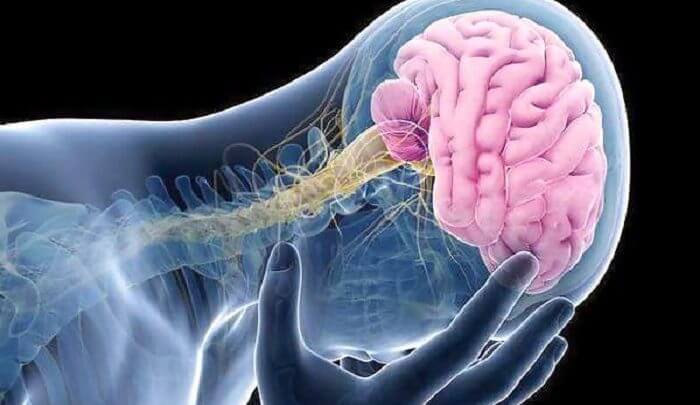Cerebrospinal fluid has the function of protecting the central nervous system, ensuring circulation and electrolyte balance in the nervous system. It can be understood simply that cerebrospinal fluid is seen as the membrane protecting the brain and spinal cord.
When the body has abnormalities related to the nervous system, the cerebrospinal fluid test, will detect signs of disease, contribute to early diagnosis for timely treatment.
Learn About Cerebrospinal Fluid
For normal healthy adults, the average body contains about 150-180ml of cerebrospinal fluid.
Cerebrospinal fluid is a clear, colorless fluid. According to research, the similarities of cerebrospinal fluid and plasma were found. However, there is no fibrinogen or bilirubin and very little cholesterol.
Cerebrospinal fluid is structured as a plasma ultrafiltration fluid, in the subarachnoid cavity, cerebral basins, and ventricles.

the central nervous system
The function of cerebrospinal fluid includes:
• Cerebrospinal fluid is seen as a buffer layer to help protect the central nervous system (brain and spinal cord) against mechanical stress.
• Participates in the metabolism of the central nervous system such as ensuring the stable circulation of the nervous system, antibodies, hormones, and white blood cells.
• The one-way flow of cerebrospinal fluid also helps transport substances, balance electrolytes, and regulate the pH of the central nervous system.
Because of these important roles, when the central nervous system is damaged, the cerebrospinal fluid will also have corresponding changes.
What Is the Cerebrospinal Fluid Test?
It can be simply understood that the CSF test is a clinical approach that aims to check the condition of the cerebrospinal fluid, helping doctors measure the pressure in the cerebrospinal fluid.
The test results will serve as the basis for the detection, diagnosis, and treatment of diseases related to the central nervous system such as myelitis, meningitis, and brain cancer.

Thus, the results of the cerebrospinal fluid test have a very important meaning in the diagnosis, treatment, and monitoring of the disease, as follows:
Diagnose
For diagnosis, thanks to cerebrospinal fluid test, it is significant to detect and contribute to the diagnosis of diseases such as:

• Bacterial diseases that affect the nervous system include meningitis, myelitis, and encephalitis.
• Malignant diseases in the early stages such as meningeal cancer, scattered sclerosis, squeezing syndrome, nerve multiple root inflammation …
• Diseases that have not yet found the cause of the disease, most notably seizures, epilepsy, confusion, or confusion …
• In case of suspecting subarachnoid bleeding, but still have normal results when computed tomography.
Treatment:
• Helping to bring antibiotics to treat CNS or nerve root diseases.
• Use local anesthetic for surgery with spinal anesthesia.
• Help to introduce specific medications into the cavity below the spinal cord.
Follow the results of treatment:
For some cases, the cerebrospinal fluid test also helps monitor treatment results through the CSF index as follows:
Normal cerebrospinal fluid when viewed with the eyes will be transparent, colorless.
The pH of the cerebrospinal fluid is normal at 7.4 – 7.6.
The density of the cerebrospinal fluid is normal at 1,006 – 1,009.
The viscosity of the cerebrospinal fluid in the permissible level is 1.01 – 1.06.
Cerebrospinal Fluid Test Procedure
Currently, with the advancement of medicine and modern equipment, there are methods of taking cerebrospinal fluid in a quick time and reducing pain for patients.

Depending on the case, different ways will apply including:
Poke Cisternal
Cisternal is performed by specialists through the technique of inserting a needle under the occipital bone (located behind the skull) to extract the required amount of cerebrospinal fluid.
This method is performed by a fluorescent conductor. However, this is a highly dangerous method.
Ventricular puncture
Ventricular puncture is a method that is rarely used in common cases, is mostly performed in the operating room, and is recommended for patients at risk of cerebral herniation.
When conducting, specialist doctors will need specialized medical tools, then apply the technique to drill a hole in the patient's skull, insert the needle directly through the hole drilled straight into the ventricles to take cerebrospinal fluid.
Lumbar spinal puncture
In addition to the above two methods, lumbar puncture is currently the most popular method because of its high safety. The procedure for a spinal puncture involves the following steps:
• The patient needs to do some tests such as an anesthetic reaction test, blood clotting test … to check the health condition that meets the requirements for it to be performed.
• During the procedure, the patient will lie on the bed, leaning in a position with the knee bent to the chest.
• The doctor will locate the needle puncture in the waist, conduct a wide antiseptic around the needle puncture area, then inject the local anesthetic.
• Insert the needle into the location of the defined spine to suck cerebrospinal fluid about 1-10ml, and measure the pressure at the cerebrospinal fluid.
• Remove the needle from the patient's body, perform disinfection, clean and cover the injection site with medical gauze.
• After completing the procedure the patient needs to rest for a short time.
Although this is a highly safe method, there are certain risks that a patient may face after a spinal fluid aspiration: headache, infection in the wound (abscess, punctured meningitis), or epidural bleeding.
Cerebrospinal Fluid Test Results
Normal cerebrospinal fluid: Clear color, cerebrospinal fluid pressure (80 -100) 70-120mm water column, DNT's viscosity is 1.01- 1.06, pH is 7.4 -7.6 The density of the cerebrospinal fluid is from 1.006 to 1.009.
The cerebrospinal fluid is opaque: the number of cells increases (500-1000 leukocytes / mm3), the risk of infection, meningitis, also the accumulation of white blood cells or the protein.
Cerebrospinal fluid contaminated with blood: This is an indication that the patient is bleeding or blocked in the spinal cord.
Cerebrospinal fluid is orange, yellow, or browning: This is an indication of the possibility that the patient has experienced an increase in CSF protein or has recently experienced bleeding.
However, it is also possible that blood from the spinal cord makes the pulp of the marrow the color of blood, so to be sure more tests will be needed to confirm.
Not only through the color will help recognize the signs of disease, but thanks to the brain's spinal fluid index also reflect the abnormal changes of the body.
Meningitis: The spinal fluid is cloudy, the number of cells increases to 500 – 1000 leukocytes / mm3, of which most are polymorphonuclear leukocytes, glucose is reduced markedly, NaCl is normal, Total protein increased at 100 – 300 mg /% when culturing cerebrospinal fluid with bacteria growing (pneumococcus, meningococcal …)
Viral meningitis: Cerebrospinal fluid is transparent, protein usually increases only slightly, cells increase mainly lymphocytes. Testing the inflammatory reactions Pandy and Nonne-Appelt will be positive.

Tuberculosis meningitis
Cerebrospinal fluid turns lemon yellow, transparent, the pressure of cerebrospinal fluid increases, cells increase from a few tens to a few hundred cells / mm3.
When in the early stages leukocytes have neutral and lymphatic manifestations. Later, lymphoma dominated and increased to 70 – 90%.
If the solution is deposited in a test tube and observed after 24 hours, there will be a floating phenomenon, decreased glucose and salt, and a slight increase in protein. Thanks to cerebrospinal fluid culture, TB bacteria can be seen.
Stroke
For patients with intracranial hemorrhage: Cerebrospinal fluid may contain blood that does not clot in a test tube. Protein will be increased due to blood flowing into the subarachnoid space, the proportion of cellular components in the cerebrospinal fluid noticed a similarity in blood.
For people with cerebral parenchymal hemorrhage and near the ventricle or subarachnoid space: Observing the cerebrospinal fluid can also be bloody, but with a small amount of blood, the cerebrospinal fluid usually changes only slightly color. light pink. If the blood has been bleeding for many days before, then only bilirubin is found to be tested.
For patients with cerebral infarction (cerebral artery occlusion 🙂 Cerebrospinal fluid pressure usually increases slightly, protein also increases slightly, cells with normal results and other tests do not detect abnormalities.
Brain tumors: Measure high CSF pressure, protein-cell dissociation with increased protein expression (usually reaching levels above 100mg% but meanwhile the number of other cells remains normal).
Thus, thanks to the results of the cerebrospinal fluid test on parameters, colors, and reaction tests, the cerebrospinal fluid composition testing will be meaningful in detecting and diagnosing neuropathy.
Based on the test results, depending on the case of the disease, doctors will have an appropriate treatment regimen that brings positive effects.
For more information about our test menu and price list, please click here.
The site cannot and does not contain medical advice. The medical information is provided for general informational and educational purposes only and is not a substitute for professional advice. Accordingly, before taking any actions based upon such information, we encourage you to consult with the appropriate professionals.

 1900 1717
1900 1717 